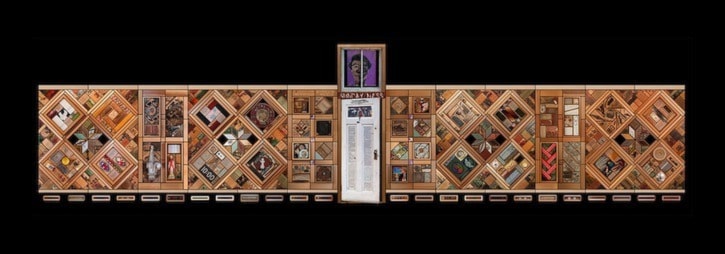Back in 2011, Kwakwaka’wakw Master Carver Carey Newman started on a project which would take the better part of a two years to complete. The Witness Blanket, a project spawned by the Truth and Reconciliation Commission which came to Victoria in 2011, became a reality in 2014 when it began touring in British Columbia.
The Witness Blanket bears witness to the experience of residential schools for Canada’s native people. Newman’s father Victor was a residential school survivor and when he finally told his story, it deeply affected Carey in a profound way. He couldn’t let those or the stories and experiences of others who were sent away from their families rest as they had been for a generation or more.
“It really tells the story,” said Carey’s mother Edith Newman of the finished project.
The story is the bits and pieces of history as told and evidenced by residential school survivors. It is truth in a physical way, an artifact saved because of the significance to its holder.
The call went out in 2012 for artifacts from the schools, those pieces of history that somehow survived through the years. They are the visible to the invisible remembrances.
The 10 foot by 40 foot installation is a long wall in four panels and includes such things as bricks, doors, buttons, shoes and plates. Those seemingly insignificant pieces are combined into the whole making a strong and powerful piece stitched together with memories. The wooden blocks resemble a handmade quilt.
“It’s really beautiful, even from the back,” said Newman,
Most of the metal work was done in Sooke at Maywell Wickheim’s and the whole Newman family was directly involved. At one stage both of Carey’s sisters donated their hair to the project.
“Hair is an important part of the culture,” said Edith. “When the kids arrived at residential school it was chopped off.”
Newman said they held a ceremony when the sisters cut their hair.
“It was really emotional,” she said.
The Witness Blanket project was funded through the Truth and Reconciliation Commission and Aboriginal and Northern Development Canada and the Rina M. Bidden Foundation.
Part of the project will be an interactive virtual Witness Blanket which will be an online and mobile app. Clicking onto a piece of the blanket will allow the user to get the story where that piece came from. This is being worked on presently and it will then take the place of a catalogue.
“You have to see it to get the full impact,” said Newman.
The Witness Blanket is currently on display at Capilano University in North Vancouver until December 19, then it will travel across the country to Saskatchewan, and eventually to Winnipeg where it will have a permanent home.
Moving it from city to city is expensive, roughly $10,000, and fundraising efforts are underway. There is a three-minute video on the Witness blanket at: www.indiegogo.com/projects/the-witness-blanket. There is also a documentary film being shot thanks to a grant from Canada Council. The videographers have donated their time. Donations made in the name of the Witness Blanket at the Victoria Native Friendship Centre will give the donor a tax receipt. Newman said they are happy with any donations they can get.
Others have given of their time and expertise as well, said Newman. Jane Hutchins and Robert Byers from East Sooke aided with restoration of the artifacts, Shelagh Rogers, Kate Cino, Media One, and others all gave of themselves to make this project physically and virtually real.
Other sites of interest can be viewed at:
http://www.artopenings.ca/witness-blanket.html
https://www.indiegogo.com/projects/the-witness-blanket
https://www.facebook.com/WitnessBlanket
